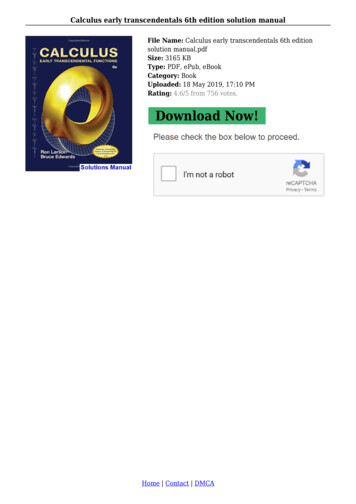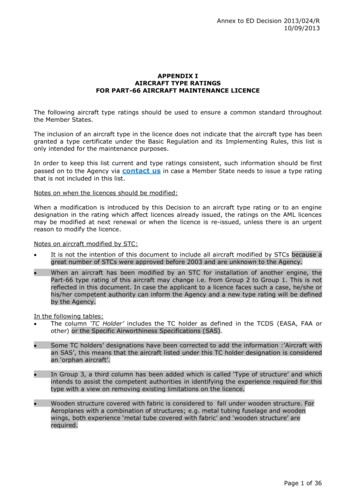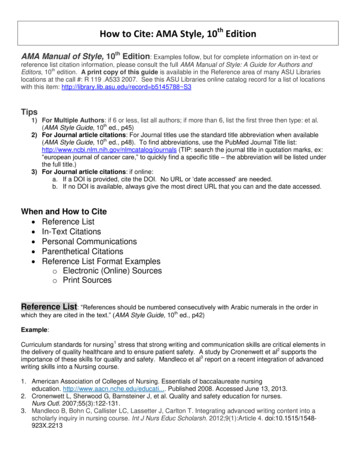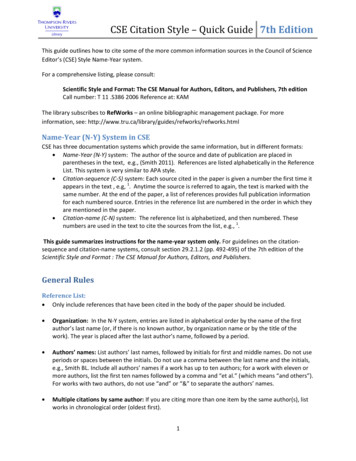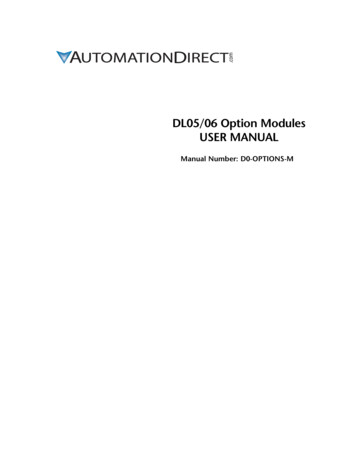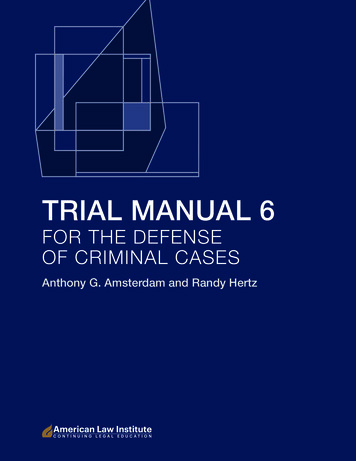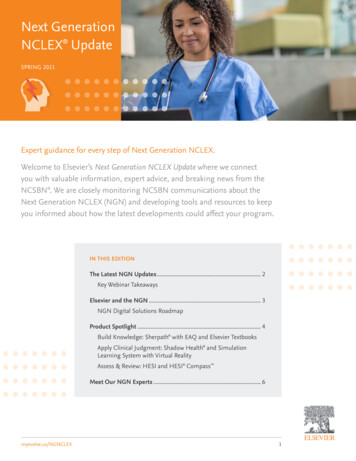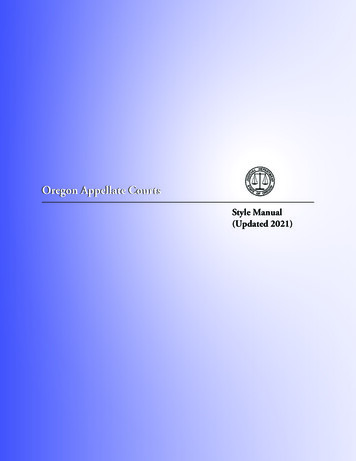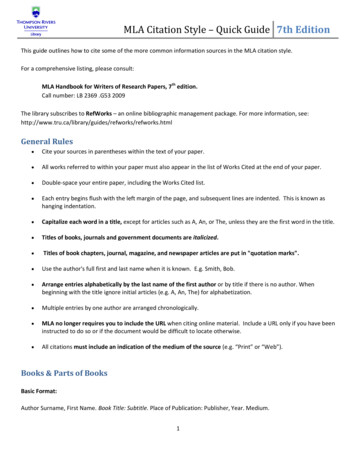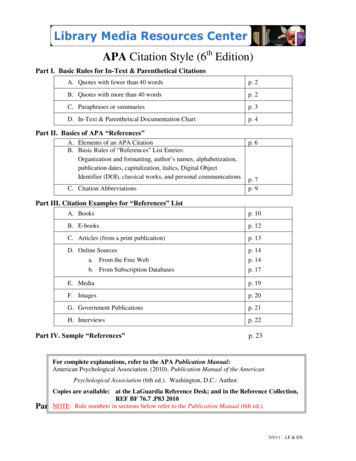
Transcription
APA Citation Style (6th Edition)Part I. Basic Rules for In-Text & Parenthetical CitationsA. Quotes with fewer than 40 wordsp. 2B. Quotes with more than 40 wordsp. 2C. Paraphrases or summariesp. 3D. In-Text & Parenthetical Documentation Chartp. 4Part II. Basics of APA “References”A. Elements of an APA CitationB. Basic Rules of ―References‖ List Entries:Organization and formatting, author‘s names, alphabetization,publication dates, capitalization, italics, Digital ObjectIdentifier (DOI), classical works, and personal communicationsC. Citation Abbreviationsp. 6p. 7p. 9Part III. Citation Examples for “References” ListA. Booksp. 10B. E-booksp. 12C. Articles (from a print publication)p. 13D. Online Sourcesp. 14a. From the Free Webb. From Subscription Databasesp. 14p. 17E. Mediap. 19F. Imagesp. 20G. Government Publicationsp. 21H. Interviewsp. 22Part IV. Sample “References”p. 23For complete explanations, refer to the APA Publication Manual:American Psychological Association. (2010). Publication Manual of the AmericanPsychological Association (6th ed.). Washington, D.C.: Author.Copies are available: at the LaGuardia Reference Desk; and in the Reference Collection,REF BF 76.7 .P83 2010Rulenumberssections belowrefer to the PublicationManual (6th ed.).Part NOTE:I. BasicRulesforinIn-Text& ParentheticalCitations5/5/11 – LF & EN
APA Style uses a combination of in-text and parenthetical citations for quoting or paraphrasing a work.(Complete bibliographical information is given only once, in the bibliography called ―References‖ on a separatepage at the end of the paper – see Parts II and III, below.)A. Quotes with fewer than 40 words:Examples:Tram and Cole (2006) studied children and early adolescents to quantify the extent to which―[d]epression predicts later depression‖ (p. 674).orResearchers have studied children and early adolescents to quantify the extent to which―[d]epression predicts later depression‖ (Tram & Cole, 2006, p. 674).1. Incorporate the quote into the text of the paper.2. Enclose in quotation marks with punctuation outside the parenthesis.3. Give these three elements:a. Author‘s last name – either in the text or in parentheses after the closing quotation mark,b. Year of publication – after the author‘s name, wherever the name appears,c. Page numbers – in the parentheses after the closing quotation mark, preceded by theabbreviation p. or pp.If page numbers are not available, give the paragraph number, if visible, preceded by theabbreviation para., or include the section subheading and count the paragraphs. If neither ofthese options exists, include only the author‘s last name and date.B. Quotes with more than 40 words:Example:Rodriquez (2005) argues that,while European immigrant experiences generally had a beginning and an end,Mexican immigration has been virtually continuous for the past century. This has madethe process of Mexican integration a perpetual one. But this dynamic hasn't so muchretarded assimilation as it has sown confusion in the formulation of political andcultural identities. (p.35)Because there has been a steady wave of immigration from Mexico to the United States,assimilated Mexican-Americans have had a more challenging time trying to gain acceptance asAmericans rather than foreigners.1. Use a block quotation. (Start on a new line, indent by a half inch, and double space.)2. Do not enclose in quotation marks.3. Give these three elements:a. Author‘s last name – either in the text before the block quotation or in parentheses after thefinal punctuation mark of the block quotation,b. Year of publication – after the author‘s name, wherever the name appears,c. Page numbers – in the parentheses after the final punctuation mark of the block quotation,preceded by the abbreviation p. or pp.2
If page numbers are not available, give the paragraph number, if visible, preceded by theabbreviation para., or include the section subheading and count the paragraphs. If neither ofthese options exists, include only the author‘s last name and date.C. Paraphrases or summaries:Example:In a study tracking fifth- and sixth-graders over four years, Tram and Cole (2006) found nosignificant differences in the stability of depressive symptoms between adolescent girls andboys (p. 682).1. Always give two elements:a. Author‘s last name – either in the text or in parentheses after the paraphrase orsummary; andb. Year of publication – either in the text or in parentheses after the paraphrase or summary.2. Page numbers – if available, are optional but recommended.3
D. In-Text & Parenthetical Documentation ChartThe table below gives examples of the most common in-text citations. The complete list of ―References‖ citedin this table appears in Part IV below.Type of source youare quoting orparaphrasingAuthor is mentioned in the text ofthe paperFirst mention ofthe source in thepaperAll subsequentmentions in thepaperAuthor is not mentioned in the textof the paperFirst mention ofsource in thepaperAll subsequentmentions in thepaper―The evidencerevealed that .‖(Beer, 2002, p.1020). (Walker &Allen, 2004, p. 27).People are lesslikely to lie when. (Beer, 2002, p.1022). (Walker &Allen,2004, p. 28). (Diessner et al.,2008, p. 320).Beer (2002) arguedthat ―.‖ (p. 1020).Beer (2002)concluded that .(p. 1022).Walker and Allen(2004) argued that―.‖ (p. 27).Walker and Allen(2004) concludedthat . (p. 28).Diessner et al.(2008) concludedthat . ( p. 320 ).Publication Manual 6.12Diessner, Solom,Frost, Parsons, andDavidson (2008)argued that . (p.314).Mulvaney et al.(2008) argued that―.‖ (p. 120).A work by a groupor agency (with areadily identifiedabbreviation)National Instituteof Mental Health(NIMH, 2009) (p. 7).NIMH (2009) (p. 11). (NationalInstitute of MentalHealth [NIMH],2009, p. 7). (NIMH, 2009, p.11).University ofPittsburgh(2003) University ofPittsburgh(2003) (University ofPittsburgh, 2003). (University ofPittsburgh, 2003).Parents living inthe Northeast areless likely to spanktheir children("Reasoning ",2010).―Parents ofpreschool childrenare more likely tospank than parentsof older children‖("Reasoning ",2010).―I had myheadphones on‖(T.K. Lutes,personalcommunication,April 18, 2001).A work by oneauthorPublication Manual 6.12A work by twoauthorsPublication Manual 6.12A work by three tofive authorsPublication Manual 6.12A work by 6 or moreauthorsMulvaney et al.(2008) concludedthat . (p. 124). (Diessner,Solom, Frost,Parsons, &Davidson, 2008, p.314). (Mulvaney etal., 2008, p. 120). (Mulvaney etal., 2008, p. 124).Publication Manual 6.13A work by a groupor agency (noabbreviation)Publication Manual 6.13A work with noauthorNot applicablePublication Manual 6.15A personalcommunication(email, in-person orphone interview,etc.)T.K. Lutes(personalcommunication,April 18, 2001)stated that .T.K. Lutes(personalcommunication,April 18, 2001)stated that .Publication Manual 6.20Cite in text only; do notinclude in “References”list.4―I never saw theirfaces‖ (T.K. Lutes,personalcommunication,April 18, 2001).
Type of source youare quoting orparaphrasingAuthor is mentioned in the text ofthe paperFirst mention ofthe source in thepaperAn indirect orsecondary source isquoted orparaphrased (i.e., aquoted quote)Publication Manual 6.17A work with no pagenumbersPublication Manual 6.05Use paragraph numbers (ifvisible) or section headingsand count paragraphnumbers in that section. Ifneither option is available,include only author’s lastname and year ofpublication.A work with nopublication datePublication Manual 6.28A republished classicor old workPublication Manual 6.18,7.02.21All subsequentmentions in thepaperFirst mention ofsource in thepaperAll subsequentmentions in thepaperAPA recommends against quoted quotes. Ifunavoidable, cite as in the following example:Former surgeon general Dr. DavidSatcher stated that young people are―dooming themselves to the difficult taskof overcoming a tough illness‖ (as citedin Crister, 2004, p. 4).Basu and Jones (2007) suggest the needfor ―regulation in cyberspace‖ (para. 4).Wright (2008) concluded that directedmarketing increases revenues(Conclusion section, para. 1).Bohrer (2010) argues that ―as a politicaljournalist, Wallace was ahead of histime.‖Not applicableThere is a need for ―regulation incyberspace‖ (Basu & Jones, 2007, para.4).Focused marketing to specific consumersegments increases revenue (Wright,2008, Conclusion section, para. 1).David Foster Wallace was ahead of histime as a political journalist (Bohrer,2010)The group, Peoplefor EthicalTreatment ofAnimals (PETA,n.d.) argues that― ‖PETA (n.d.)believes that―vegetariansare ‖―Vegetarians are50% less likely todevelop heartdisease‖ (Peoplefor the EthicalTreatment ofAnimals [PETA],n.d.).Children who eatvegetarian dietsgrow taller thanmeat eatingchildren (PETA,n.d.)Laplace(1814/1951) heldthe deterministview that (p. 4)Laplace(1814/1951)explained that (p. 8)―We may regardthe present state ofthe universe as theeffect of its pastand the cause of itsfuture‖ (Laplace,1814/1951, p. 4).―The probability ofevents serves todetermine the hopeor the fear ofpersons interestedin their existence‖(Laplace,1814/1951, p. 20).1 Cor. 13:2When available, includethe original publicationdate.In 1 Cor. 13:1(Revised StandardVersion), it isstated that ― ‖orIslamic teachingexplains that― ‖ (Qur‘an 5:34).Classic religiousworkPublication Manual 6.18Author is not mentioned in the textof the paperNot applicableCite in text only; do notinclude in “References”list.5(Qur‘an 5:3-4)
Part II. Basics of APA “References”A. Elements of a Citation6
B. The Basic Rules of “References” List EntriesThe list of all the sources you cited in your paper is called ―References.‖For illustrations of the following rules, see sample ―References‖ list (Part IV, below).1)Include the ―References‖ list, on a separate sheet, at the end of your paper, with the word―References,‖ centered at the top (without quotation marks).2)Double-space the ―References‖ list.3)Use hanging indents for each entry (i.e., indent all lines after the first line of each entry, onehalf inch from the left margin).4)Authors‘ namesa) Invert all authors' names (i.e, give last or family name first).b) For all first and middle names, give initials only.c) For a work with 8 or more authors, list the first 6 authors, insert an ellipsis ( ), andthen add the last author‘s name. (see Piper entry below)5)No author listed (Publication Manual 6.15, 7.15)a) Enter works with no author by title of the article, Web page, or book. (see―Reasoning‖ entry below)6)Alphabetization (Publication Manual 6.25)a) Alphabetize by the first word in each entry (usually the last name of the first author).b) List works with the same single author or the same multiple authors in the same orderby year of publication, starting with the earliest. (see Stiles entries below)c) List works with the same single author or the same multiple authors in the same orderand published in the same year alphabetically by title. (see Stiles entries below)7)Publication dates always go in parentheses:a) (year) – for a book or a scholarly journalb) (year, Month or Season) or (year, Month day) – for magazine or newspaper articles(see Reasoning and Brody entries below)c) (n.d.) – if no date is available (see PETA entry below)8)Capitalizationa) In titles of books, articles, and Web pages, capitalize only the first letter of the firstword of the title and subtitle, the first word after a colon or a dash, and proper nouns.b) In journal titles, capitalize all major words.c) Do not capitalize the first letter of the second word in a hyphenated compound word.(see Cantor entry below)7
9)Italicsa) Italicize titles of longer works such as books, journals or websites.b) Italicize periodical volume numbers.c) Do not italicize (or underline or put quotation marks around) titles of shorter workssuch as magazine or journal articles, Web pages, essays or chapters in edited books.10)Digital Object Identifier (DOI) (Publication Manual 6.31-2, 7.01)a) Important change in the 6th edition of APA style: For scholarly sources availableonline, APA recommends providing the DOI (Digital Object Identifier). The DOI is aunique alphanumeric code that provides a stable, long-lasting link for online articles.If the DOI is available, it is to be found the first page of an article.(See Cantor, Piper, and Stiles entries below)b) If there is no DOI, provide the database name or the URL of the article found on thefree Web. (See Basu entry below)11)Classical works (Publication Manual 6.18)―References‖ list entries are not required for major classical works (e.g., ancient Greek and Romanworks, religious texts). Identify the version used when the work is first mentioned in the text and usechapter, verse, or line numbers in a parenthetical citation in the text.12)Personal communications (Publication Manual 6.20)Because personal communications, including interviews and emails, do not provide ―recoverabledata,‖ they are not included in the ―References‖ list. They are cited only in the text. (For an example,see In-Text & Parenthetical Documentation Chart above.)8
C. Citation Abbreviations (Publication Manual, 4.02,Edition :Use ed.Revised edition:Use Rev. ed.Second Edition:Use 2nd ed.Editor or Editors:Use Ed. or Eds.Translator or Translators:Use Trans.No date:Use n.d.Page or pages:Use p. or pp.ParagraphUse para.Volume or Volumes:Use Vol. or Vols.Number:Use No.Part:Use Pt.Technical Report:Use Tech. Rep.Supplement:Use Suppl.6.22)For legal and governmental abbreviations: See Publication Manual A7.019
Part III. Citation Examples for “References” ListAt the end of your paper, you must provide an alphabetical listing of all the works you have cited. Thisrequirement includes both works you have actually quoted and works from which you have summarized orparaphrased. The information is arranged alphabetically according to the author‘s last name or, when no authoris named, by title.III.A. Books (Publication Manual, 7.02)Elements:Author, A. A., & Author, B. B. (Year of Publication). Title of work. (# ed.) Place of publication:Publisher.Book by a single author (Publication Manual, 7.02.18)Crister, G. (2004). Fat land: How Americans became the fattest people in the world. Boston: HoughtonMifflin.Book by two to seven authors (Publication Manual, 6.27, 7.02)Hamilton, J. M., & Krimsky, G.A. (1996). Hold the press: The inside story on newspapers. Baton Rouge:Louisiana State University Press.Wong, D. L., Hockenberry-Eaton, M., Wilson, D., Winkelstein, M. L., Ahmann, E., & DiVito-Thomas, P. A.(1999). Whaley & Wong's nursing care of infants and children (6th ed.). St. Louis: Mosby.Book by a corporate author (Publication Manual, 6.27)American Medical Association. (1998). Essential guide to asthma. New York: Pocket Books.Book by an editor (Ed.) or editors (Eds.) (Publication Manual, 6.27)Adshead, G., & Jacob, C. (Eds.). (2009). Personality disorder: The definitive reader. London: JessicaKingsley Publishers.Johnson, A. G. (Ed.). (2000). The Blackwell dictionary of sociology: A user’s guide to sociological language(2nd ed.). Malden, MA: Blackwell.Book with author and editor (Publication Manual, 6.27, 7.02)Plath, S. (2000). The unabridged journals. K.V. Kukil (Ed.). New York: Anchor.Translation (Publication Manual, 7.02.21, 26)Laplace, P. S. (1951). A philosophical essay on probabilities. (F. W. Truscott & F. L. Emory, Trans.). NewYork: Dover. (Original work published 1814)Edition (Publication Manual, 7.02.30)Macionis, J. J. (2007). Sociology (11th ed.). Upper Saddle River, NJ.: Prentice Hall.Book with no author (Publication Manual, 6.27, 7.02)Collins quotation finder (Rev. ed.). (2001). Glasgow: Harper Collins.Online book (Publication Manual, 7.02.19-22)See Part III.B on page 12.10
III.A. Books (continued) (Publication Manual, 7.02)Parts of Books:Chapter in an edited book (Publication Manual, 7.02.21)Hatt, B. (2007). Growing up as poor, white trash: Stories of where I come from. In J. A. Van Galen & G.W. Noblit (Eds.), Late to class: Social class and schooling in the new economy (pp. 19-28).Albany: State University of New York Press.Excerpt from a book, reprinted in an anthology (Publication Manual, 7.02.26)Colon, J. (2003). Little things are big. In M. M. Watts (Ed.), College: We make the road by walking (pp.90-91). Upper Saddle River, NJ: Prentice Hall. (Reprinted from A Puerto Rican in New York andother sketches, pp.115-117, 1982, New York: International Publishers).Signed article in an encyclopedia (Publication Manual, 7.02.29-30)Cleland, H. G. (2004). Child labor. In The encyclopedia Americana (Vol. 6, pp. 460-463). Danbury,CT: Grolier.Unsigned article in an encyclopedia (Publication Manual, 7.02.29-30)Highway speed limits, by state. (2008). In S. Janssen (Ed.), The world almanac and book of facts (p.78).New York: World Almanac Books.11
III.B. E-books (Publication Manual, 7.02.19-22)ElementsFor an entire e-book:Author, A. A., & Author, B. B. (Year of Publication). Title of work. DOI or Retrieval statement.For part of an e-book:Author, A. A., & Author, B. B. (Year of Publication). Title of chapter or entry. In A. Editor & B. Editor (Eds.),Title of work (pp. xx-xx). DOI or Retrieval statement.Entire e-book (Publication Manual, 7.02.19-20)Angell, J. R. (1905). Psychology: An introductory study of the structure and function of human consciousness(3rd ed.). New York: H. Holt and Company. Retrieved from http://books.google.comSchiradi, G. R. (2001). The post-traumatic stress disorder sourcebook: A guide to healing, recovery, andgrowth. doi:10.1036/0071393722E-book from a subscription databaseLois, J. (2003). Heroic efforts: The emotional culture of search and rescue volunteers. New York: New YorkUniversity Press. Retrieved from ebrary database.Chapter in or section of a republished book, online versionFreud, S. (1953). The method of interpreting dreams: An analysis of a specimen dream. In J. Strachey (Ed. &Trans.), The standard edition of the complete psychological works of Sigmund Freud (Vol. 4, pp. 96121). Retrieved from http://books.google.com (Original work published 1900)12
III.C. Articles (from print publications) (Publication Manual, 7.01)Elements:Author, A. A., Author, B. B., & Author C. C. (Date of Publication). Title of article. Title of Publication,Volume#(Issue#), pp-pp.NOTE: Precede page numbers for newspaper articles (and book chapters) with p. for a single page and pp. for twoor more pages. For magazine and journal articles, do not include p. or pp.Article in a scholarly journal (Publication Manual, 7.01.3)Duley, K. (2006). Un-domesticating violence: Criminalizing survivors and U.S. mass incarceration. Women &Therapy, 29(3/4), 75-96.Article in a magazine (Publication Manual, 7.01.7)Chaberlin, J., Novotney, A., Packard, E., & Price, M. (2008, May). Enhancing worker well-being:Occupational health psychologists convene to share their research on work, stress, and health. Monitoron Psychology, 39(5), 26-29.Article in a newspaper (Publication Manual, 7.01.10)Schwartz, J. (1993, September 30). Obesity affects economic, social status. The Washington Post, pp. A1, A4.Editorial, signed (Publication Manual, 7.01.14)Harding, R. (2009, November 28). A growing disaster. [Editorial]. The New York Times, p.19.Editorial, unsigned (Publication Manual, 7.01.14)Haiti‘s schools. [Editorial]. (2010, August 17). The New York Times, p. 26.Article with no author (Publication Manual, 7.01)The decade of the spy. (1994, March 7). Newsweek, 26-27.Book review (Publication Manual, 7.06.45)Schatz, B. R. (2000, November 17). Learning by text or consent? [Review of the book The social life ofinformation, by J. S. Brown & P. Duguid]. Science, 290, 1304.Chapter in an edited book or work in an anthology (Publication Manual, 7.02.25)Hatt, B. (2007). Growing up as poor, white trash: Stories of where I come from. In J. A. Van Galen & G. W.Noblit (Eds.), Late to class: Social class and schooling in the new economy (pp. 19-28). Albany: StateUniversity of New York Press.Excerpt from a book, reprinted in an anthology (Publication Manual, 7.02.26)Colon, J. (2003). Little things are big. In M. M. Watts (Ed.), College: We make the road by walking (pp. 9091). Upper Saddle River, NJ: Prentice Hall. (Reprinted from A Puerto Rican in New York and OtherSketches, pp.115-117, 1982, New York: International Publishers).Article in an encyclopedia, signed (Publication Manual, 7.02)Cleland, H. G. (2004). Child labor. In The encyclopedia Americana (Vol. 6, pp.460-463). Danbury,CT: Grolier.Article in an encyclopedia, unsigned (Publication Manual, 7.02)Highway speed limits, by state. (2008). In S. Janssen (Ed.), The world almanac and book of facts (p.78). NewYork: World Almanac Books.13
III.D.a. Online Sources from the Free Web (Publication Manual, 7.01.9, 11, 7.03, 7.11)ElementsOnline articlesAuthor, A. A., Author, B. B., & Author C. C. (Date of Publication). Title of article. Title of Publication,Volume#(Issue#), pp-pp. DOI or Retrieved from URLWeb pages or Web documentsAuthor, A. A., Author, B. B., & Author C. C. (Date of Publication). Title of Web page or Web document.Retrieved from Name of Publisher/Website*: URLNOTE: The title of a Web page is not italicized because it is a subordinate part of a larger work (the website).Exception: Titles of PDF files should be italicized.*NOTE: For documents retrieved online, identify the publisher as part of the retrieval statement unless thepublisher has been identified as the author (Publication Manual, 7.03).Entire websitesAuthor, A. A. or Corporate Author. (Date of Publication). Title of Website. Retrieved from URLOnline mediaProducer, A. A. (Producer), & Director, B. B. (Date). Title of video or sound recording. [Medium]. Retrievalstatement.Article from an online scholarly journal (Publication Manual, 7.01.1, 3)Basu, S. & Jones, R. (2007). Regulating cyberstalking. Journal of Information, Law & Technology, (2).Retrieved from 7 2/basu jones/Tram, J. M., & Cole, D. A. (2006). A multimethod examination of the stability of depressive symptoms inchildhood and adolescence. Journal of Abnormal Psychology 115(4), 674-686. doi: 10.1037/0021843X.115.4.674Article in an online magazine (Publication Manual, 7.01.8)Armey, D. (2008, September 29). My vote: No: Dealing with the deal. National Review Online. Retrievedfrom http://article.nationalreview.comArticle from a newspaper website (Publication Manual, 7.01.11)Brody, J. E. (2007, December 11). Mental reserves keep brain agile. The New York Times. Retrieved fromhttp://www.nytimes.comFerrechio, S. (2009, July 23). Compromise would give board Medicare-cutting powers. The WashingtonExaminer. Retrieved from http://www.washingtonexaminer.comBook or Film review (Publication Manual, 7.06.45)Anderson, S. (2010, August 12). The precisionist [Review of the book Freedom, by J. Franzen]. New YorkMagazine. Retrieved from http://nymag.comArticle in an online reference book (Publication Manual, 7.02.29, 30)Bhutan. (2008). Encyclopedia Britannica Online. Retrieved from http://www.britannica.comGraham, G. (2005). Behaviorism. In E. N. Zalta (Ed.), The Stanford encyclopedia of philosophy (Fall 2007ed.). Retrieved from http://plato.stanford.edu/entries/behaviorism14
Non-periodical article from a websiteLessig, L. (2007, May 4). Free debates: More republicans call on RNC. Retrieved fromhttp://www.lessig.org/blog/2007/05/free debates more republicans.htmlTutton, M. (2008, September 11). Designers developing virtual-reality ‗cocoon‘. Retrieved from the CableNews Network website: ocoon/index.htmlWeb page with no dateLinder, D. (n.d.). The Rosenberg trial. Retrieved from the University of Missouri-Kansas City School of Lawwebsite: osenb/rosenb.htmWeb page with no author (Publication Manual, 7.02.30)Attachment disorder. (2010, February 21). Retrieved from Wikimedia Foundation website:http://en.wikipedia.org/wiki/Attachment disorderSafe communities—safe schools. (n.d.). Retrieved from University of Colorado at Boulder eb page with a corporate author (Publication Manual, 7.03.31, 32, 35)LaGuardia Community College, Office of Institutional Research & Assessment. (2009). 2009 Institutionalprofile. Retrieved from iversity of Pittsburgh, Technology Commercialization Alliance. (2003). For innovators. Retrieved fromhttp://www.pitt.edu/tca/innovators.htmlEntire websiteLajoie, G., McLellan, A., & Seddon, C. (2010). Bully b’ware. Retrieved from http://www.bullybeware.comNational Renewable Energy Laboratory. (2009, August 20). Learning about renewable energy. Retrieved fromhttp://www.nrel.gov/learning/Blog entry or comment (Publication Manual, 7.11.76)AcademicBee. (2009, March 18). Trying too hard to get ahead [Blog post]. Retrieved ying too hard.phpTwitter post (Publication Manual, 7.11)Nealschumanpub. (2009, November 3). Coming in November: Stephanie Matta ―A few good books‖!Retrieved from http://twitter.com/nealschumanpub/ status/5402110982NOTE: Use the tweet as the title (enough of it to serve as an identifiable title) and give the unique URL.Online InterviewButler, C. (Interviewee) & Stevenson, R. (Interviewer). (1999). Oral history 2 [Interview transcript]. Retrievedfrom Johnson Space Center Oral Histories Project website:http://www11.jsc.nasa.gov/history/oral histories/oral histories.htmBarnes, P. J. (Interviewee) (2010, February). Chronic Obstructive Pulmonary Disease (COPD). Retrieved fromScienceWatch website: http://sciencewatch.com/ana/st/copd/ 10febcopdBarn/15
Online video (Publication Manual, 7.07, 7.11.77)Bilgil, M. (Director). (2009, January 4). History of the Internet [Video file]. Retrieved fromhttp://www.youtube.com/watch?v icjDBGTHCGQC-Span. (Producer). (2008, September 3). Vice Presidential candidate Gov. Sarah Palin (AK) full speech atthe RNC [Video file]. Retrieved from http://www.youtube.com/watch?v UCDxXJSucF4Leonard, A. (Writer). (2007). The story of stuff [Video file]. Retrieved from http://www.storyofstuff.com/Online sound recording (Publication Manual, 7.07.50)Radiolab. (2008, December 12). Yellow fluff and other curious encounters [Sound recording]. Retrieved fromWNYC Radio website: 2/12Van Nuys, D. (Producer). (2007, December 19). Shrink rap radio [Audio podcast]. Retrieved fromhttp://www.shrinkrapradio.com/Online image (Publication Manual, 7.07.53)Britton, I. (Photographer). (n.d.). Tree, sunrise, Northumberland [Photograph]. Retrieved from FreeFoto LLCwebsite: http://www.freefoto.com/preview/15-19-1?ffid 15-19-1.Lewis County Geographic Information Services (Cartographer). (2002). Population density, 2000 U.S. Census[Demographic map]. Retrieved from http://www.co.lewis.wa. us/publicworks/ maps/ Demographics/census-pop-dens 2000.pdf16
III.D.b. Online Sources from Subscription Databases(Publication Manual, 7.01.2, 17, 7.02.22, 7.05.40)Elements:Author, A. A., Author, B. B., & Author C. C. (Date of Publication). Title of article. Title of Publication(Edition), Volume#(Issue#), pp.-pp. DOI or Retrieved from Name of database.NOTE: Precede page numbers for newspaper articles (and book chapters) with p. for a single page and pp. for twoor more pages. For magazine and journal articles, do not include p. or pp.Article in a scholarly journalWright, R. E. (2008). Targeting, segmenting and positioning the market for college students to increasecustomer satisfaction and overall performance. College Student Journal, 42(3), 891-894. Retrievedfrom Academic Search Complete database.Article in a scholarly journal (with up to seven authors) (Publication Manual, 7.01.1)Diessner, R., Solom, R. C., Frost, N. K., Parsons, L., & Davidson, J. (2008). Engagement with beauty:Appreciating natural, artistic, and moral beauty. The Journal of Psychology, 142(3), 303-329.Retrieved from Proquest Platinum Periodicals database.Maguen, S., Cohen, G., Cohen, B. E., Lawhon, G. D., Marmar, C. R., & Seal, K. H. (2010). The role ofpsychologists in the care of Iraq and Afghanistan veterans in primary care settings. ProfessionalPsychology: Research and Practice 41, 135-142. doi: 10.1037/a0018835Article in a scholarly journal (with eight or more authors) (Publication Manual, 7.01.2)Kochan, T., Bezrukova, K., Ely, R., Jackson, S., Joshi, A., Jehn, K., Thomas, D. (2003, Spring). The effectsof diversity on business performance: Report of the Diversity Research Network. Human ResourceManagement, 42(1), 3-21. doi: 10.1002/hrm.10061orKochan, T., Bezrukova, K., Ely, R., Jackson, S., Joshi, A., Jehn, K., Thomas, D. (2003, Spring). The effectsof diversity on business performance: Report of the Diversity Research Network. Human ResourceManagement, 42(1), 3-21. Retrieved from Academic Search Complete database.NOTE: Include first six authors’ names, then insert three ellipses ( ), and add the last author’s name.Article in a magazine (Publication Manual, 7.01.7)Margonelli, L. (2008, September). Gut reactions. Atlantic Monthly, 302(2), 76-82. Retrieved from AcademicSearch Complete database.Walker, B., & Allen, E. (2004, November 11). Could they solve the skills shortage? Caterer & Hotelkeeper,193(4349), 26-29. Retrieved from Business Source Complete database.Article in a newspaperHedgpeth, D. (2009, August 4). Cash for clunkers deal drives auto sales. The Washington Post (Suburban ed.),p. A11. Retrieved from LexisNexis Academic database.McCarthy, R. J. (2009, July 21). State Senate gridlock likely to affect re-elections, poll finds. Buffalo News, p.B2. Retrieved from New York State Newspapers database.17
The Scientists speak. [Editorial]. (2007, November 20). The New York Times (Late ed.), p. A22. Retrievedfrom LexisNexis Academic database.Book review (Publication
APA. Citation Style (6. th. Edition) Part I. Basic Rules for In-Text & Parenthetical Citations . A. Quotes with fewer than 40 words p. 2 B. Quotes with more than 40 words p. 2 C. Paraphrases or summaries p. 3 D. In-Text & Parenthetical Documentation Chart p. 4 . Part II. Basics of . APA "References" A. Elements of an APA Citation p. 6
